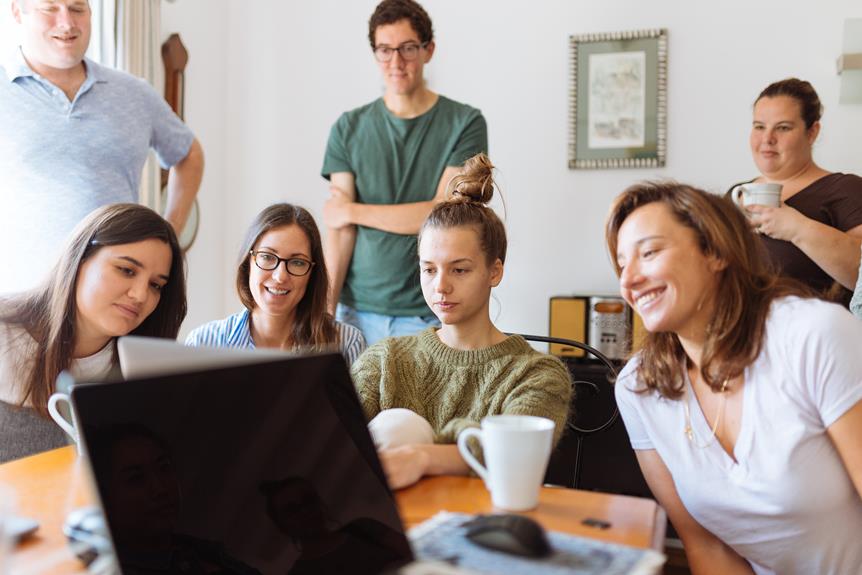Looking to take your meditation practice to the next level? Ever wondered what it takes to lead a meditation group? Well, look no further!
In this article, we'll guide you through the essential steps and techniques for successfully leading a meditation group. From setting the foundation to nurturing group dynamics, we've got you covered.
So, are you ready to embark on this transformative journey with us? Let's dive in and explore the art of leading a meditation group!
Setting the Foundation: Establishing the Purpose and Vision
You should begin by clarifying the purpose and vision for your meditation group. This is essential to establish a strong foundation and guide your group towards a common goal.
Start by establishing clear goals that you want to achieve through your meditation sessions. Are you aiming to provide a space for relaxation and stress relief, or do you want to focus on personal growth and self-discovery?
Once you have defined your goals, it's important to also define the principles that will guide your group. These principles can include values such as compassion, mindfulness, and non-judgment.
Creating a Welcoming Environment: Setting Up the Physical Space
To create a welcoming environment for your meditation group, it's important to carefully set up the physical space. Creating ambiance is crucial to help participants feel relaxed and at ease. Consider dimming the lights or using soft, calming lighting to create a peaceful atmosphere.
You can also incorporate soothing music or nature sounds to enhance the overall experience.
When arranging seating, make sure it's comfortable and conducive to meditation. Provide cushions or mats for those who prefer to sit on the floor, and chairs for those who prefer a more supported position.
It's also a good idea to have enough space between participants to allow for personal space and movement.
Guiding the Practice: Techniques for Effective Meditation Sessions
During the meditation sessions, it's important to provide clear instructions and gentle guidance to help participants deepen their practice and maintain focus. One effective technique is to start the session with mindful breathing. Encourage participants to focus on their breath, observing the inhalation and exhalation without judgment. This helps to anchor the mind and cultivate present moment awareness. Another technique is the use of visualization. Guide participants to imagine a calm and peaceful place, such as a beach or a forest. Encourage them to visualize the details, like the sound of the waves or the smell of the trees. This visualization helps to relax the mind and create a sense of tranquility. By incorporating these techniques, you can lead effective meditation sessions that allow participants to experience deep relaxation and inner peace.
| Technique | Description |
|---|---|
| Mindful Breathing | Focusing on the breath to cultivate present moment awareness and anchor the mind. |
| Visualization | Guiding participants to imagine a calm and peaceful place to relax the mind and create a sense of tranquility. |
Nurturing Group Dynamics: Fostering Connection and Support
Creating a sense of connection and support within the meditation group is essential for fostering a positive and nurturing environment. To achieve this, there are two key aspects to focus on: building trust and building community.
- Building trust: Cultivate a safe and non-judgmental space where participants feel comfortable sharing their experiences and vulnerabilities. Encourage open communication and active listening, allowing everyone to feel heard and respected. This will help establish a strong foundation of trust among the group members.
- Building community: Facilitate group bonding and mutual support by organizing activities that encourage interaction and collaboration. Encourage participants to share their meditation journeys, insights, and challenges with one another. Foster a sense of belonging by creating opportunities for group members to connect outside of the meditation sessions, such as through social events or online forums.
Embracing Challenges: Handling Difficulties and Resolving Conflicts
When facing challenges or conflicts within your meditation group, it's important to approach them with patience, understanding, and a willingness to find resolution.
Handling disagreements and resolving conflicts requires promoting open communication among group members. Encourage everyone to share their thoughts and concerns openly and honestly. Create a safe and non-judgmental space where each person feels heard and respected.
As the leader, actively listen to both sides of the conflict and strive to find common ground. Facilitate a constructive dialogue, encouraging empathy and understanding. Help group members see the situation from different perspectives and find solutions that benefit everyone involved.
Remember that disagreements are natural and can lead to growth when handled with compassion and openness. By promoting open communication, you can foster a harmonious and supportive environment within your meditation group.
Frequently Asked Questions
How Do I Choose the Right Meditation Technique for My Group?
To choose the right meditation technique for your group, consider their needs and preferences. Group dynamics play a role in selecting the technique that will resonate with everyone. Seek input and create a practice that fosters harmony.
What Should I Do if Someone in the Group Becomes Emotional During a Meditation Session?
When someone in the group becomes emotional during a meditation session, support their emotions with compassion. Handle their reactions with patience and understanding. Create a safe space for them to express and process their feelings.
How Can I Encourage Participation From All Members of the Group?
To encourage participation from all members of the group, focus on inclusive facilitation and active engagement. Create a welcoming space, encourage open communication, and offer various meditation techniques to cater to different preferences and needs.
What Are Some Strategies for Dealing With Distractions During Group Meditation?
When distractions arise during group meditation, it's essential to maintain focus. By acknowledging the distractions without judgment and gently guiding participants back to their breath or mantra, you create a space for deepening their practice.
How Do I Address Conflicts That Arise Between Group Members Outside of the Meditation Sessions?
To address conflicts between group members outside of meditation sessions, focus on conflict resolution and understanding group dynamics. Encourage open communication, active listening, and empathy to promote a harmonious and supportive environment within the group.
Conclusion
In conclusion, leading a meditation group requires:
- Setting a strong foundation
- Creating a welcoming space
- Guiding the practice effectively
- Nurturing group dynamics
- Embracing challenges
By establishing a clear purpose and vision, setting up a comfortable environment, utilizing effective techniques, fostering connection and support, and addressing difficulties and conflicts, you can successfully lead a meditation group.
Embrace the opportunity to guide others in their journey towards inner peace and self-discovery, and watch as your group flourishes and grows.








